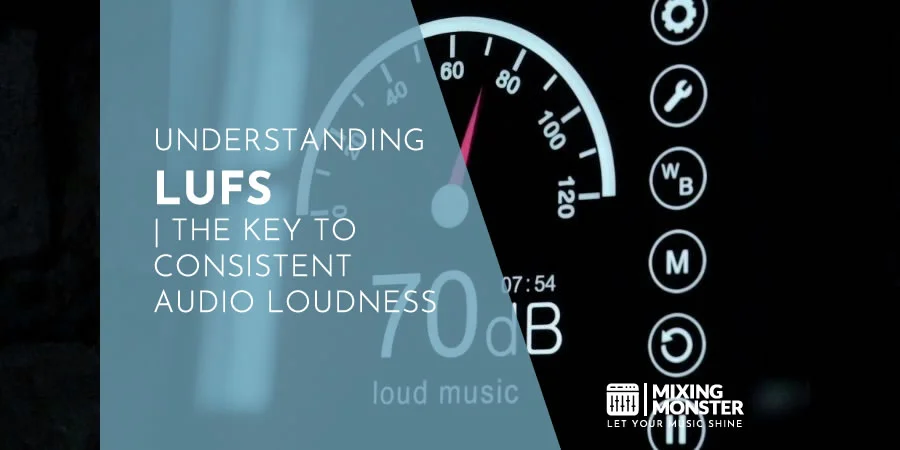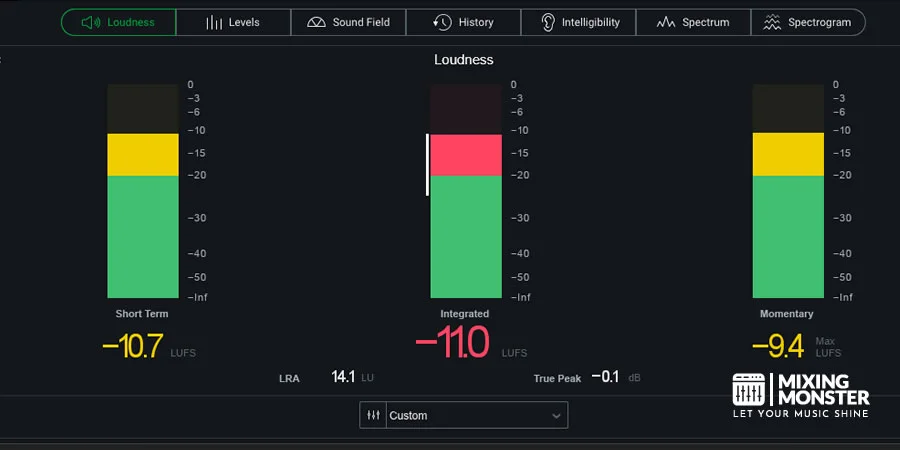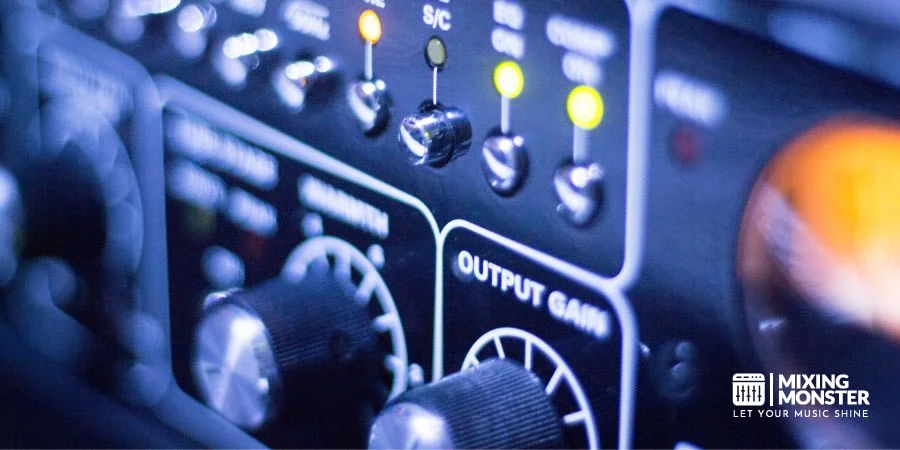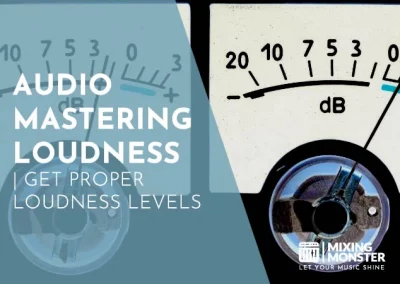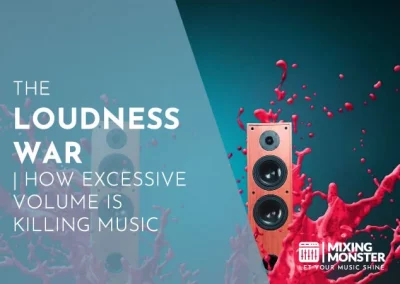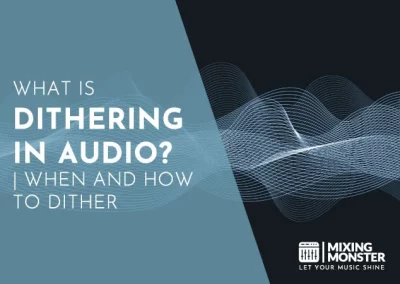Home > Blog > Mastering > Mastering Insights
When it comes to producing audio content, maintaining consistent loudness levels across different platforms and devices is essential. This is where LUFS (Loudness Units relative to Full Scale) come in. In this article, we’ll explore what LUFS are, how they are used, and why they are important in audio production.
LUFS (Loudness Units relative to Full Scale) is a unit of measurement used to determine the loudness level of audio content relative to the maximum level that a digital system can handle. It is a standardized measurement that takes into account both the short-term and long-term loudness levels of a piece of audio, providing a more accurate representation of its perceived loudness.
Did you ever wonder why some songs or podcasts sound louder and more consistent than others? LUFS may hold the answer. Learn more about this standardized measurement and how it’s used to ensure consistent loudness levels in audio production and streaming.
Table Of Contents
1. What Are LUFS And How Are They Used To Measure Loudness?
2. How Are LUFS Different From Other Loudness Measurements?
3. Advantages Of Using LUFS Over Other Loudness Measurements
4. The Importance Of LUFS In Audio Production
5. Commonly Used LUFS Standards In Audio Production
6. LUFS And Streaming Platforms
7. How To Measure LUFS
8. The Role Of LUFS In The Audio Mastering Process
9. Conclusion

1. What Are LUFS And How Are They Used To Measure Loudness?
LUFS stands for Loudness Units relative to Full Scale. It is a standardized measurement used to determine the perceived loudness of audio content.
Unlike other measures of loudness, LUFS takes into account both the short-term and long-term loudness levels of a piece of audio, providing a more accurate representation of its perceived loudness.
LUFS measures the loudness of audio relative to the maximum level that a digital system can handle, known as Full Scale (FS). This measurement is used in audio production, broadcasting, and streaming to ensure consistent loudness levels across different platforms and devices.
An example of how LUFS are used to measure loudness in audio production is in broadcast television. Broadcasting organizations need to ensure that their content has consistent loudness levels, regardless of the program or advertisement that is being aired. If the loudness levels are inconsistent, it can be uncomfortable for the viewer and may even cause them to change the channel.
To achieve consistent loudness levels, broadcasting organizations use LUFS to measure the loudness of their content. They use specialized loudness meters to measure the loudness levels of the audio during the production process and ensure that they meet the specific LUFS standards that are required by their country’s broadcasting regulations.
For example, in the United States, the ATSC A/85 standard specifies a maximum loudness level of -24 LUFS for television content. By using LUFS to measure loudness, broadcasting organizations can ensure that their content meets the required loudness levels, regardless of the source or content of the audio. This ensures a more consistent and enjoyable viewing experience for the viewer.
By using LUFS, audio engineers can avoid abrupt changes in loudness that can be irritating to listeners and improve the overall listening experience.
2. How Are LUFS Different From Other Loudness Measurements?
LUFS is different from other loudness measurements such as dBFS, dB SPL, and dB(A) in several ways.
Firstly, dBFS (decibels relative to Full Scale) is a measurement of digital signal levels, while LUFS is a measurement of perceived loudness. dBFS is used to measure the peak level of a digital audio signal, while LUFS takes into account the average and dynamic range of the audio signal.
Secondly, dB SPL (decibels Sound Pressure Level) and dB(A) are measurements of acoustic pressure levels, while LUFS is a measurement of perceived loudness. dB SPL is used to measure the pressure level of sound waves, while dB(A) is a weighted measurement of the pressure level that takes into account the frequency response of the human ear.
Lastly, LUFS is a standardized measurement, while the other measurements can vary depending on the context and application. LUFS takes into account the specific characteristics of human hearing and is used to ensure consistent loudness levels across different platforms and devices, while the other measurements are used for specific purposes such as measuring the peak levels of a signal or the pressure level of sound waves.
3. Advantages Of Using LUFS Over Other Loudness Measurements
There are several advantages to using LUFS over other loudness measurements such as dBFS, dB SPL, and dB(A).
One of the primary advantages of LUFS is its ability to provide a more accurate representation of perceived loudness. Again, unlike other measurements, which focus on specific aspects of the audio signal, LUFS takes into account both the average and dynamic range of the audio signal, providing a more comprehensive and accurate measurement of loudness.
When measuring audio loudness in LUFS, three common types of measurements are used: short-term, integrated, and momentary.
Short-term measurements, as the name implies, are measurements taken over a short period, usually three seconds. This type of measurement is useful for capturing changes in loudness over a short period, such as during a sudden burst of sound.
Integrated measurements, on the other hand, are taken over a more extended period, typically the entire track’s duration. This measurement is useful for capturing the overall loudness level of a track and is the most commonly used measurement for determining loudness levels in LUFS.
Finally, momentary measurements are taken over very short periods, usually 400 milliseconds. This type of measurement is useful for capturing very brief changes in loudness, such as during a drum hit or a transient in the audio.
By using these different types of measurements, audio professionals can get a more complete picture of the loudness of a track and make more informed decisions when it comes to adjusting the track’s loudness level in LUFS.
Another advantage of LUFS is its ability to provide consistency in loudness levels across different platforms and devices. Since LUFS is a standardized measurement, it ensures that the perceived loudness of the audio content is consistent, regardless of the source or playback device. This helps to avoid abrupt changes in loudness that can be unpleasant to listeners.
Additionally, LUFS is able to provide more reliable loudness measurements across different types of audio content, such as music, speech, and sound effects. This is because LUFS takes into account the specific characteristics of human hearing, which can vary depending on the type of content being listened to.
4. The Importance Of LUFS In Audio Production
As already mentioned, LUFS is extremely important in audio production as it ensures consistent loudness levels across different platforms and devices.
In today’s world, where audio content is consumed across a wide range of devices and platforms, it is essential to have a standardized method of measuring loudness that is consistent across all mediums.
By using LUFS in audio production, producers can ensure that their content has a consistent loudness level, regardless of where it is played back.
Furthermore, LUFS are used to comply with various broadcasting and streaming regulations, which require specific loudness levels to be met. This ensures that the content is compliant with industry standards and is suitable for broadcast on various platforms and devices.
The importance of LUFS in audio production cannot be overstated. By using LUFS to measure loudness levels, producers can ensure a consistent and enjoyable listening experience for their audience.

5. Commonly Used LUFS Standards In Audio Production
There are several LUFS standards that are commonly used in audio production and broadcasting, each with their own specific requirements and applications.
One of the most widely used standards is EBU R128, which was developed by the European Broadcasting Union (EBU). EBU R128 specifies a target loudness level of -23 LUFS for broadcast and streaming content, as well as a maximum true peak level of -1 dBTP (decibels true peak). This standard is commonly used in Europe and other parts of the world.
Another widely used standard is ATSC A/85, which was developed by the Advanced Television Systems Committee (ATSC). ATSC A/85 specifies a target loudness level of -24 LUFS for television content in the United States, as well as a maximum true peak level of -2 dBTP.
In addition to these standards, there are several other LUFS standards that are used in specific applications. For example, Netflix has developed its own loudness standard, which specifies a target loudness level of -27 LUFS for its content.
The use of these standards is important in ensuring that audio content is compliant with industry regulations and provides a consistent listening experience. By adhering to these standards, audio producers can ensure that their content meets the specific requirements of broadcasters and streaming services.
The use of LUFS standards is essential in the production of high-quality audio content that meets industry regulations.
6. LUFS And Streaming Platforms
Streaming platforms like Spotify and Apple Music use LUFS to ensure that playback volume is consistent across different tracks. This is important because different tracks can have different loudness levels, and sudden changes in volume can be jarring for listeners.
To achieve this consistency, these platforms use a normalization process that adjusts the loudness of each track to a target loudness level. This target loudness level is usually around -14 LUFS, although some platforms may use different levels.
Here is a table of some of the most popular streaming platforms and their target loudness levels:
| Streaming Platform | Target Loudness Level |
| Spotify | -14 LUFS |
| Apple Music | -16 LUFS |
| Tidal | -14 LUFS |
| Deezer | -14 LUFS |
| Amazon Music | -14 LUFS |
| YouTube Music | -14 LUFS |
A standard target loudness level provides a better listening experience for users, as they don’t have to constantly adjust the volume between tracks.
It’s important to note that normalization can sometimes result in a loss of dynamic range and can affect the intended artistic expression of the track. Therefore, some artists and producers choose to master their tracks specifically for streaming platforms, using techniques such as loudness range targeting to preserve the dynamic range while still achieving a consistent playback volume.
7. How To Measure LUFS
To measure LUFS, a variety of tools and methods are used in audio production. These include loudness meters, plugins, and software.
Loudness meters are hardware or software devices used to measure the loudness of audio signals. They provide a numerical readout of the loudness level in LUFS, allowing producers to accurately measure the perceived loudness of their audio content. Some popular loudness meter brands used in audio production include TC Electronic and Dorrough.
Plugins are software tools that are used within a digital audio workstation (DAW) to manipulate and process audio signals. Many plugins include loudness metering features that allow producers to measure the loudness of their audio content directly within the DAW.
These plugins can be used to monitor the loudness levels of individual tracks or the overall mix, and can provide real-time feedback on how changes in volume affect the loudness level.
Popular Loudness Meter Plugins:
- iZotope Insight:
A comprehensive metering and audio analysis plugin that includes loudness metering features. - Waves WLM:
A loudness metering plugin that provides accurate measurements of peak and average loudness levels. - Nugen Audio VisLM:
A loudness metering plugin that provides real-time loudness monitoring and analysis.
In addition to these tools, there are also standalone software applications that are specifically designed for measuring and analyzing loudness levels.
Popular Loudness Metering Software:
- Dolby Media Meter:
A software application for measuring and monitoring audio loudness levels in accordance with industry standards. - Orban Loudness Meter:
A software application that provides real-time loudness metering and analysis. - AudioLeak:
A loudness metering software designed specifically for Mac computers.
The use of loudness meters, plugins, and software is an important part of measuring and managing loudness levels in audio production.
8. The Role Of LUFS In The Audio Mastering Process
LUFS play a crucial role in the mastering process of audio production. Mastering is the final step in the audio production process, where the final mix is prepared for distribution. One of the primary goals of mastering is to achieve an appropriate loudness level for the final mix, without compromising its dynamic range.
Dynamic range refers to the difference between the loudest and softest parts of a track. It is an essential aspect of music production, as it allows for a more dynamic and expressive listening experience. However, if a track is not loud enough, it may not sound as impactful as it should be. Conversely, if a track is too loud, it may cause distortion and listener fatigue.
LUFS are used in the mastering process to ensure that the final mix has an appropriate loudness level while preserving its dynamic range.
By using a loudness meter to measure the overall loudness level in LUFS, the mastering engineer can adjust the mix to achieve a target loudness level without sacrificing dynamic range.
For example, if the target loudness level is -14 LUFS (like most streaming platforms demand), the engineer can adjust the levels of individual tracks within the mix to achieve that loudness level. By using a combination of volume adjustments and dynamic range processing techniques, such as compression and limiting, the engineer can achieve the desired loudness level while preserving the natural dynamics of the mix.
By carefully balancing loudness and dynamic range, the final mix can sound both powerful and expressive.
When mastering an album, the goal is to ensure that all of the tracks have consistent loudness levels that are appropriate for the genre and style of the music. This is important because if the tracks have drastically different loudness levels, it can be annoying for the listener and make it difficult to enjoy the album as a whole.
To achieve this, the audio engineer will use a loudness meter that measures loudness in LUFS. They will play each track in sequence and adjust the levels to ensure that they all have similar loudness levels.
The engineer can also use the LUFS measurement to ensure that the final master is not too loud or too quiet, which could cause distortion or other issues when the album is played back on different systems.
9. Conclusion
To wrap things up, LUFS (Loudness Units relative to Full Scale) have become an essential tool in audio production, particularly in the mastering process.
By measuring loudness levels in LUFS, engineers can ensure that a track has an appropriate loudness level without sacrificing its dynamic range. This is particularly important in today’s streaming-dominated music industry, where consistent playback volume across different platforms is crucial.
LUFS standards such as EBU R128 and ATSC A/85 have been established to ensure consistency in loudness levels across different media platforms.
With the use of various tools and methods such as loudness meters and plugins, LUFS have become an indispensable tool for audio professionals to deliver high-quality and consistent audio content.

